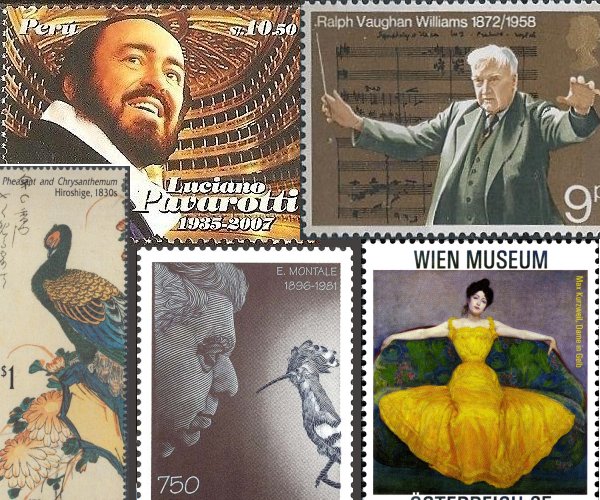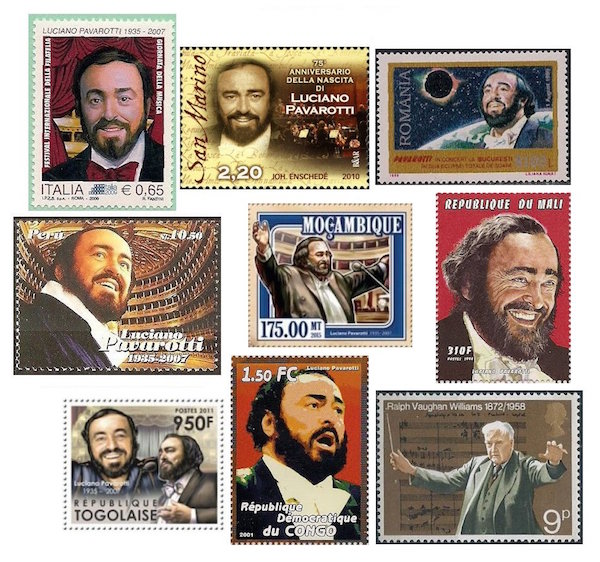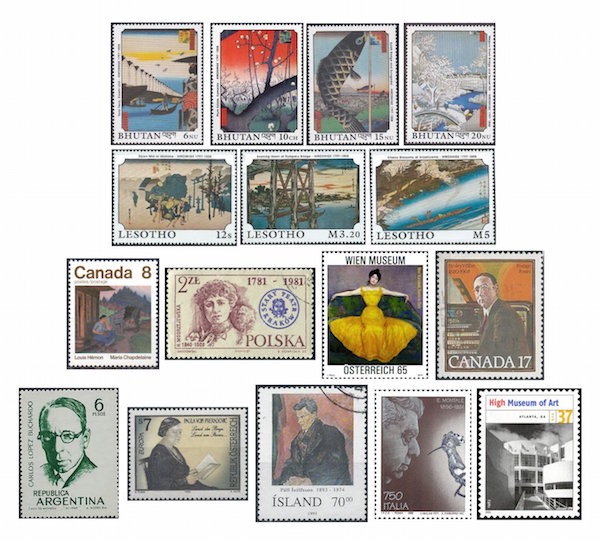The Arts on Stamps of the World —October 12
An Arts Fuse regular feature: the arts on stamps of the world.

By Doug Briscoe
Music tops our agenda today, as it is the birthday of both Ralph Vaughan Williams and Luciano Pavarotti, but we also celebrate one of the greatest Japanese artists, Hiroshige, with an abundance of beautiful stamps from around the world. And for the third day in a row we have a Nobel Prize-winning author, Eugenio Montale. In addition, eight more artistic worthies grace our page today.
Luciano Pavarotti (1935 – 6 September 2007) is so well known that I will concentrate on the philately. The stamps from Italy, Peru, and San Marino were issued posthumously, but the one from Romania came out during his lifetime to commemorate Pavarotti’s solar eclipse concert given in Bucharest on August 11, 1999. In addition to these, many souvenir sheets have been produced by African nations (Angola, Congo, Guinea, Guinea-Bissau, Malagasy, Mali, Mozambique, Niger, St Thomas, Togo…), of which I present four.
It may surprise you if you didn’t know it already that Ralph Vaughan Williams (1872 – 26 August 1958) numbered Josiah Wedgwood and Charles Darwin among his ancestors (on his mother’s side) and that as a young man he studied with Maurice Ravel. This was for three months in 1907-08, and it was in 1910 that Vaughan Williams produced one of his timeless masterpieces, the Fantasia on a Theme by Thomas Tallis. (The première of the Sea Symphony followed the next month.) Something of a late bloomer, Vaughan Williams was nearly forty, but that was all right, as he lived to be 85 and went on to strew the world of music with many more bouquets. His stamp, one of the few British composer stamps from the seemingly tone-deaf Royal Mail, was issued in 1972 for the composer’s centenary.

Speaking of flowers, they were a specialty, along with birds and landscapes, by the Japanese ukiyo-e master Utagawa Hiroshige, born in 1797, who died on this date in 1858. But before we embark on a lengthy traversal of his art on stamps, we begin with a portrait of the artist by Utagawa Kunisada (1786–1865). Birds and landscapes outnumber the flowers on stamps, for some reason, and we have enough birds ro devote the rest of the collage to them. Next to the portrait stamp is one from The Gambia of Falcon on Perch, Sparrow, and Narcissus, and next to that is a small souvenir sheet from Antigua and Barbuda showing Bullfinch Flying Near a Clematis Branch. In the next row the two unusually tall stamps from Palau and Micronesia offer respectively A Little Bird Amongst Chrysanthemum and Pheasant and Chrysanthemum, both dating from the 1830s. The set of four, again from Antigua, consists of Crane and Wave, Crested Blackbird and Flowering Cherry, Goose on a Bank of Water, and Black Paradise Flycatcher and Blossoms. All the stamps in the bottom row come from Ajman except the one in the center, a monochrome Japanese issue from 1949 of the print Moon & Geese. Moving on to Collage No. 3 we see four stamps from a lovely set from Bhutan, all of which represent examples from Hiroshige’s One Hundred Famous Views of Edo, published between 1856 and 1859: Yoroi Ferry at Koami District, Plum Estate in Kameido, Suidō Bridge and the Surugadai Quarter (with the fish in the foreground), and a winter scene: Meguro Drum Bridge and Setting Sun Hill. The stamps of Lesotho show prints from three earlier series, The Fifty-three Stations of the Tokaido (1831-34), Famous Places of Kyoto (1835), and Famous Views of the Eastern Capital (1831): from left to right, they are Dawn Mist of Mishima Station, Twilight Moon at the Ryogoku Bridge, and Cherry Blossoms of Arashiyama.
The French writer Louis Hémon (12 October 1880 – 8 July 1913) was born in Brest and studied law and oriental languages in Paris, then moving for a time to London before emigrating to Montreal in 1911. Hémon wrote his novel Maria Chapdelaine while working at a farm. Sadly, he was killed by a train at the age of 33 before the book became an enormous success. Translated into more than 20 languages, it also inspired a series of paintings by Croatian-born Canadian artist Rajka Kupesic. I’m not certain, but the image on the stamp may be one of these.
The particulars of the life of Polish actress Helena Modjeska (October 12, 1840 – April 8, 1909) are as involved as those of any stage plot. Born at Kraków, her name was recorded at birth as Jadwiga Benda (her putative father’s name—he was deceased), then at her baptism as Helena Opid (her godfather’s name). It seems she may have been the illegitimate daughter of a nobleman, one Prince Władysław Sanguszko (vwa-DEE-swahf sahn-GOOSH-ko). Then, at a point lost to history, she married her former guardian, an actor called Gustave Sinnmayer (or Gustaw Zimajer), who used the stage name Gustaw Modrzejewski (mod-zhe-YEF-ski), but years later Helena learned that all along he had still been married to his first wife. When Helena began acting outside Poland, she simplified the name to Modjeska (mod-YES-ka). She first trod the boards in 1861 and appeared the next year in Lwów in a play by Juliusz Słowacki. From 1868 she worked in Warsaw and established her reputation as a star Shakespearean actress. She also in that year married her second husband, a lesser nobleman, Karol Bozenta Chłapowski (khwa-POF-ski), who passed himself off as a count. In 1876 they decided to leave for America, where she and “Count Bozenta” continued their on-stage partnership. They bought property near Anaheim, hoping, it seems, to adopt the lifestyle of ranchers with horses ‘n’ guns ‘n’ all. But they knew nothing about ranching, so Modjeska returned to the stage, appearing in San Francisco, then the east coast, and London. Although Modjeska still acted under the handicap of a rather thick accent, she became a great success, coming to be regarded as the preeminent female interpreter of Shakespeare in America. She had become an American citizen in 1883, and in that year produced Henrik Ibsen‘s play A Doll’s House in Louisville, Kentucky, in what was the first occasion of an Ibsen play being staged in the United States. She essentially retired from the stage in 1907, apart from the odd appearance in support of charity. Helena Modjeska died of Bright’s disease in Newport Beach, California, aged 68. Her remains were sent to Kraków.

Next we turn to the Austrian Jugendstil painter and graphic artist Max Kurzweil (12 October 1867 – 9 May 1916), one of the founders of the Vienna Secession movement in 1897. He studied in Vienna and Paris, exhibiting at the Salon in 1894. He was editor and illustrator of the Secessionist magazine Ver Sacrum (Sacred Spring). Plagued by depression and ill luck, he entered into a suicide pact with his student and lover Helene Heger. Though less well known, he is grouped together with Gustav Klimt and Egon Schiele as an important proponent of the Secessionist movement. The Austrian stamp of 2010 shows his arresting oil Woman in a Yellow Dress of 1899.
English-born Canadian composer and organist Healey Willan (1880–1968) was enormously prolific, having written some 800 works, his reputation lying mainly in the area of liturgical works in the Anglican tradition. But there are also at least seven operas, incidental music, two symphonies, a piano concerto, music for band, chamber works, keyboard pieces, and songs. He began his career in 1895 as an organist and choirmaster at various London-area churches. He emigrated to Canada in 1913 and worked in the same capacity at St. Paul’s, Toronto’s largest church. He was made head of the Toronto Conservatory’s Theory Department in 1920. Later he became the school’s Vice-Principal.
The Argentine composer Carlos López Buchardo (1881–1948) was born and died in Buenos Aires. He went to Paris in 1909 for study with Albert Roussel and/or Vincent d’Indy. (One source refers to Roussel without reference to d’Indy, the other just the opposite.) He founded both the Conservatorio Nacional in Buenos Aires and the School of Fine Arts at La Plata University. After his death the conservatory was renamed for him. He was also director of the Teatro Colón. As a composer, he wrote operas, musical comedies, masses, songs, and piano pieces. His work, inspired by native music, was presented by such distinguished conductors as Erich Kleiber, Fritz Busch, Victor de Sabata, and Wilhelm Furtwängler!
The novelist and poet Paula Preradović (12 October 1887 – 25 May 1951) came of a distinguished family, her grandfather a poet, her father an historian, both members of the Austro-Hungarian military. Born in Vienna, Paula went as a child to Istria and Dalmatia and grew up on the Adriatic coast. She studied modern languages and from the age of 18 aspired to be a poet. During the First World War she worked as a nurse and married the diplomat, journalist, and historian Ernst Molden. Both of them and their son Fritz were active in the anti-Nazi underground. Arrested after the plot to assassinate Hitler in July 1944, she narrowly escaped being sent to Mauthausen concentration camp. She published her first volume of poetry in 1929 and her first novel, Pave and Pero, a story about her grandparents, in 1940. In 1946 she was asked to compose the lyrics for a new Austrian national anthem, which was adopted in February of 1947 and remains in place today. Her stamp came out in 1996.
Páll Ísólfsson (1893 – 23 November 1974) was an Icelandic composer, organist, pianist, and conductor. Max Reger was among his teachers at the Leipzig Conservatory. In addition to his post as the first rector of the Reykjavík College of Music, he was head of the music department of the Icelandic State Radio for about 30 years. As a performer he traveled widely, including tours in the United States and the USSR, and made some solo recordings for HMV. He is one of those composers whose name was unknown to me until I discovered his stamp, then I bought a Bis CD of his solo piano pieces. (Enh.) His orchestral Festival March and Festival Overture can be found on a Chandos disc.

As mentioned above, for the third consecutive day we have a Nobel Laureate in our midst. (Ivo Andrić was born on the 9th, Claude Simon—and Harold Pinter, stampless—on the 10th.) Italian poet and prose writer Eugenio Montale (12 October 1896 – 12 September 1981) was born in Genoa. The youngest of six sons, he was pretty much given free rein to do as he pleased, and followed his passion of literature, though he also studied opera singing. His first poetry collection appeared in 1925 and was followed by nine more, along with stories, translations, and travel writing. From 1927 in Florence he was a frequent contributor to literary magazines, but as an antifascist he was removed from his position as chairman of the Gabinetto Vieusseux Library in 1938. From 1948 he lived in Milan, receiving the Nobel Prize for Literature in 1975.
We conclude today with American architect Richard Meier (born October 12,1934), whose buildings, the Barcelona Museum of Contemporary Art (1995), the Getty Center in Los Angeles (1997), the Paley Center for Media (formerly the Museum of Television and Radio) in Beverly Hills (1996), the Atheneum in New Harmony, Indiana (1979), and, as seen on the postage stamp, the High Museum of Art in Atlanta (1983), reflect the dominance of the color white in Meier’s conceptual world. The earlier work of Le Corbusier has been a strong influence. Meier won the Pritzker Prize in 1984.
The late Dick Gregory (October 12, 1932 – August 19, 2017) would have been 87 today. There is no stamp, but there is a philatelic quote. The comedian and civil rights activist once said, “I am really enjoying the new Martin Luther King Jr stamp – just think about all those white bigots, licking the backside of a black man.” (The two US MLK stamps, from 1979 and 1999, both came out before self-adhesives became the norm.)
A graduate of the University of Massachusetts with a B.A. in English, Doug Briscoe worked in Boston classical music radio, at WCRB, WGBH, and WBUR, for about 25 years, beginning in 1977. He has the curious distinction of having succeeded Robert J. Lurtsema twice, first as host of WGBH’s weekday morning classical music program in 1993, then as host of the weekend program when Robert J.’s health failed in 2000. Doug also wrote liner notes for several of the late Gunther Schuller’s GM Recordings releases as well as program notes for the Boston Classical Orchestra. For the past few years he’s been posting a Facebook “blog” of classical music on stamps of the world, which has now been expanded to encompass all the arts for The Arts Fuse.
